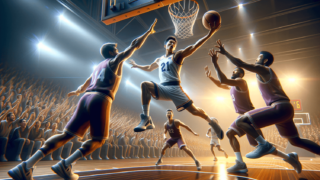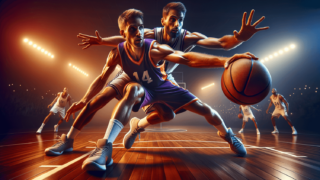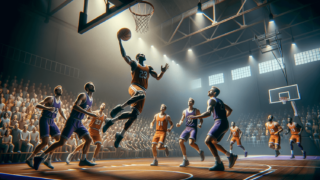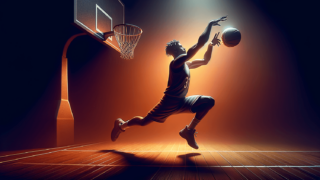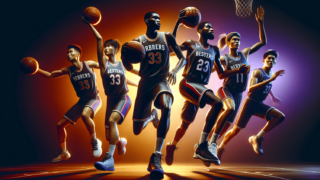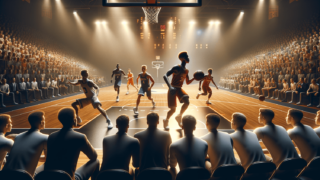
How to Improve Your Court Vision in Basketball?
Written by: Basketball Universe
Last updated:

Welcome to the hoop-lovers paradise, where we dive deep into the world of basketball and explore every nook and cranny that the game has to offer! Today’s topic? Court vision, an essential skill that separates good players from great ones. As a passionate basketball enthusiast looking to elevate your game, you’ve come to the right place. In this blog post, we will delve into the techniques and strategies that can sharpen your court vision, positioning you as a playmaker who can read the floor like a pro. So grab a beverage, lace up your sneakers, and let’s embark on this exciting journey to unlock your full potential on the hardwood!
How to Improve Your Court Vision in Basketball?
To improve your court vision in basketball, focus on enhancing peripheral vision, anticipating plays, and strengthening communication with teammates. Practice scanning the court and tracking player movements without turning your head. Drills such as “Nash Vision” and “Two-Ball Dribble” can help develop awareness and decision-making skills. Participate in pick-up games and watch basketball footage to study and analyze playmaker strategies, which will ultimately boost your court vision.
Master Your Peripheral Vision
Peripheral vision is the key to unlocking exceptional court vision in basketball. Players with great court vision can see the entire court and detect movements in their peripheral while focusing on the ball or their defender. This allows them to react quickly to changing situations and create scoring opportunities for their teammates.
Peripheral Vision Drills
Here are some effective drills to enhance your peripheral vision:1. Corner Vision Drill: Place two bright-colored objects (cones or shirts) at the corners of the court. Stand at the free-throw line and dribble the ball while keeping your eyes on the hoop. Use your peripheral vision to detect the position of the objects as you dribble. Once you’ve found both objects, pass the ball to a teammate or take a shot.2. Three-Person Peripheral Drill: One player stands in the middle of the court with a ball, while two teammates stand on the wings. These two teammates will alternate raising their hands. The player in the middle dribbles and must call out which teammate raised their hand without turning their head. This exercise helps develop the ability to see movements on the sides of the court.Remember, consistency is key. Practice these drills regularly for the best results.
Anticipate the Play and Develop Decision-making Skills
Great court vision requires understanding the game’s tactics and anticipating how plays develop. This knowledge allows players to make smart decisions and react quickly in changing situations. Developing decision-making skills goes hand-in-hand with improving your court vision.
Developing Anticipation and Decision-making
Improve your anticipation and decision-making skills by:1. Studying the Game: Watch basketball games and analyze the playmakers’ moves. Take note of how they read the defense and create scoring opportunities.2. Play Chess: Chess is an excellent way to sharpen your decision-making skills and strategic thinking. Incorporate this into your training routine to see improvement on the court.3. On-Court Practice: Participate in pick-up games and team scrimmages. These real-game situations will help you develop the ability to read players and make quick decisions.
Enhance Your Basketball IQ
An essential component of court vision is having a solid understanding of the game. A high basketball IQ enables you to see things develop before they happen and make smart decisions on the court.
Boost Your Basketball IQ
Here’s how you can enhance your basketball IQ:1. Learn the Fundamentals: Develop a strong foundation in basketball techniques, such as passing, dribbling, shooting, and defensive stances. Additionally, learn various offensive and defensive strategies.2. Watch and Analyze Basketball Games: Observe professional and college games to pick up on plays, defensive schemes, and players’ tendencies. The more you watch and analyze, the better your understanding will become.3. Ask Questions and Learn from Others: Talk to coaches, teammates, and more experienced players for insights and new perspectives on your game. Be open to feedback and learning.
Develop Effective Communication Skills
Communication can make or break a team’s success on the court, and strong court vision goes hand-in-hand with effective communication. By improving your ability to communicate with teammates, you can maximize your court vision and team performance.
Improving On-the-Court Communication
Utilize these tips to enhance your communication skills:1. Call Out Defensive Assignments: Inform your teammates of picks, screens, and who they should be guarding. This helps everyone stay on the same page defensively.2. Give Directions on Offense: As a player with great court vision, you’ll spot opportunities and plays that your teammates may not see. Guide them with clear instructions, such as where to cut, pass or set screens.3. Listen to Teammates: Good communication goes both ways. Listen to your teammates’ input and take it into account for better overall teamwork.
Drills to Improve Court Vision
There are numerous drills that can help you boost your court vision. Let’s explore some of the best that you can incorporate into your training routine.
Nash Vision Drill
This drill, named after legendary point guard Steve Nash, improves your court vision while maintaining ball control. To perform this drill, you will need a partner who will act as a defender by holding up their fingers or hands in various positions. Dribble around the court while keeping your eyes on your partner and calling out the number of fingers they’re holding up. Focus on controlling the ball and maintaining good posture throughout the drill.
Two-Ball Dribble
This drill combines dribbling practice with court vision. Start by dribbling two basketballs down the court while keeping your eyes up to survey the floor. The added complexity of handling two balls challenges your ability to maintain proper form and awareness. As you improve, ask a partner to hold up fingers at different points on the court so you can call out the number of fingers while dribbling.
No-Look Pass Drill
Train your ability to see teammates without staring directly at them with the no-look pass drill. Form a line of players near the baseline, and have a passer positioned near the free-throw line. As each player cuts towards the hoop, the passer must deliver a no-look pass, using their peripheral vision to time the pass correctly. Rotate through the line multiple times, ensuring each player practices both passing and cutting.
Study Legendary Playmakers
Learning from the best is an effective way to develop your court vision. Study the techniques and strategies used by legendary playmakers to enhance your understanding and application of court vision on the basketball court.
Great Playmakers to Study
Players worth observing include:1. John Stockton: Known for his exceptional passing and court vision, John Stockton held the all-time NBA assists record. He read the game with ease and found teammates with pinpoint accuracy.2. Steve Nash: A two-time MVP, Nash was a maestro of the pick-and-roll and had incredible vision that enabled him to create open looks for his teammates.3. Jason Kidd: With excellent all-around skills and elite court vision, Kidd frequently executed no-look passes and was among the all-time leaders in assists and steals.4. LeBron James: Although predominantly known as a forward, LeBron has often played point forward and demonstrated outstanding passing abilities and court vision.
Remember, practice makes perfect, and these legendary playmakers have spent countless hours refining their skills on the court. Dedicate yourself to learning from them and constantly improving your basketball game. With consistent effort and determination, you’ll notice significant progress in your court vision and overall performance on the hardwood.
Embrace Visualization Techniques
Visualization is a powerful technique that many professional athletes, including basketball players, use to improve their in-game performance. By regularly practicing visualization, you can sharpen your court vision, as well as enhance reaction times, decision-making, and mental toughness.
How to Use Visualization for Better Court Vision
Follow these steps to integrate visualization into your basketball training routine:1. Find a Quiet Space: Choose a comfortable, quiet location free from distractions to practice visualization.2. Get Comfortable: Sit or lie down in a relaxed position, taking deep breaths to clear your mind and relieve any tension.3. Imagine Game Scenarios: Close your eyes and picture yourself playing basketball. Visualize the court, the players, the ball, and the overall atmosphere.4. Focus on Specific Skills: Within the game scenarios, hone in on aspects related to court vision. Imagine scanning the court, spotting open teammates, anticipating opponents’ movements, and making smart decisions.5. Repetition: Consistency is vital for reaping visualization’s full benefits. Aim to practice visualization techniques regularly for substantial improvement.
Condition Your Body for Better Performance
Physical conditioning plays a significant role in a player’s ability to showcase their court vision skills during competition. Improving your strength, agility, and endurance can boost your overall performance on the court, which in turn can help you better demonstrate your enhanced court vision.
Important Conditioning Workouts
These workouts will help you build your basketball body:1. Cardiovascular Exercises: Incorporate running, cycling, and swimming into your exercise routine to enhance your stamina and endurance.2. Strength Training: Building muscle, especially in the core, legs, and upper body, can help you maintain stability, control, and strength on the court.3. Agility Drills: Ladder and cone drills improve your agility, speed, and quickness on the court, all of which contribute to better court vision.4. Flexibility and Balance Training: Stretching and incorporating activities like yoga can improve flexibility, balance, and overall body control, which have a positive effect on court vision.
By focusing on both physical and mental aspects of basketball, you can work towards achieving well-rounded court vision and remain one step ahead of your competition on the court.
FAQs on Improving Court Vision in Basketball
In this section, we’ll address frequently asked questions related to enhancing court vision in basketball. These concise answers are designed to help provide a better understanding of court vision and offer guidance on further improving this vital aspect of the game.
1. What is court vision in basketball?
Court vision refers to a player’s ability to see, anticipate, and respond to the movements of teammates and opponents, as well as the overall game situation. It enables players to make smart decisions, such as finding open teammates or exploiting gaps in the defense.
2. Why is court vision important in basketball?
Good court vision can provide better scoring opportunities, improve team play, and allow players to make smarter decisions on the court. It elevates individual performance and contributes significantly to a team’s success.
3. How do I develop better court vision?
Enhancing your court vision involves improving peripheral vision, anticipating plays, strengthening communication, enhancing basketball IQ, practicing drills, and studying legendary playmakers. It also requires commitment, practice, and dedication to achieving continuous improvement.
4. Can court vision be taught, or is it a natural ability?
While some players might be naturally gifted with better court vision, it is a skill that can be developed and improved through practice, drills, and studying the game. Players who apply themselves and consistently work on enhancing their court vision can reach impressive levels of performance.
5. What are some practical drills to improve court vision?
Some effective drills include the Nash Vision Drill, Two-Ball Dribble, No-Look Pass Drill, Corner Vision Drill, and the Three-Person Peripheral Drill. These drills are designed to improve peripheral vision, decision-making, play anticipation, and court awareness.
6. How does enhancing my basketball IQ impact court vision?
Improving your basketball IQ helps you make smarter decisions on the court, anticipate plays, and respond to the ever-changing game situation effectively. This enhanced knowledge results in better court vision and overall performance.
7. Which positions benefit most from superior court vision?
Point guards and playmakers usually benefit the most from exceptional court vision, as their primary role involves creating scoring opportunities and controlling the game. However, court vision is valuable for players in all positions, enhancing overall game understanding and team play.
8. How can studying legendary playmakers improve my court vision?
Studying legendary playmakers enables you to learn their techniques, strategies, and tactics, providing valuable insights and ideas to incorporate into your game. By closely analyzing their court vision skills, you can better understand how they make smart decisions and create scoring chances for their teammates.
9. Can visualization techniques help improve my court vision?
Yes, visualization techniques can significantly improve court vision. Visualization helps sharpen mental skills, such as decision-making, play anticipation, and overall court awareness, translating into improved court vision during games.
10. Does improving physical fitness contribute to better court vision?
Yes, improving physical fitness can have a positive effect on court vision. Enhanced strength, agility, and endurance provide better overall performance, allowing you to more effectively demonstrate your improved court vision and contribute to your team’s success.
Featured Posts
- No pillar pages found.
